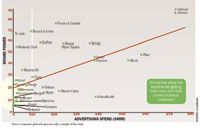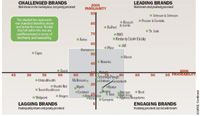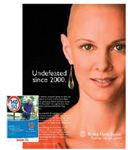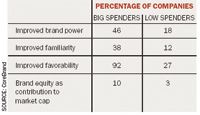The Secret
Pharmaceutical Executive
When it comes to corporate reputations, it's clear the pharmaceutical industry doesn't quite get it. (Just pick up any newspaper.) But here's the latest newsflash when it comes to managing a bad rap: You get what you pay for.
When it comes to corporate reputations, it's clear the pharmaceutical industry doesn't quite get it. (Just pick up any newspaper.) But here's the latest newsflash when it comes to managing a bad rap: You get what you pay for.

What's Your Name Worth?: Most companies that spent more than $10 million on corporate advertising increased their brand power. Companies that spent less had a difficult time breaking through the communications clutter and truly differentiating their brand-as evidenced by the cluster of low-spenders in the left-hand corner. However, there were some outliers that spent little on corporate ads but ranked high, like St. Jude Medical and Novartis, or that spent more but had less brand power, like Wyeth.
You would think that companies that gamble billions on the next blockbuster would think it was a pretty safe bet to spend a few million to communicate to its investors, employees, and the public who it is and where it wants to go. But that's simply not the case. In fact, very few companies put a meaningful amount of spending into image campaigns. In a three-year study of 46 pharmaceutical, healthcare, and diversified-consumer-products companies, 72 percent were found to significantly underinvest in building their corporate brand.
These findings show, when it comes to managing their reputation, pharmaceutical companies are missing out on the secret. So we thought we'd tell you:

Corporate advertising allows pharma companies to communicate their mission as a company. Such communications can help impact the bottom line. Bristol-Myers Squibb has excelled in this department, and its name retains an extremely strong brand equity.
People like what's familiar. And since advertising can acquaint various audiences with the company brand, it can help companies become better known and better liked. There's also evidence that, for pharma companies, improving popularity translates to better financial outcomes, such as in Wall Street's valuation of the company and its stock price.
This article explores how corporate brands gain and lose value over time. By using extensive benchmarking data, it provides insight into how different healthcare companies invest in brand building across the life-sciences landscape. This article also solidifies the value of corporate brands—which many say have value that is intangible—by quantifying companies' efforts in managing their reputation.

J&J: Omnipresent Brand Power: Johnson & Johnson has consistently invested in its corporate brand and, in the process, raised the public's awareness and favorability toward the company. Despite crises in the industry, a change in the market, and the massive growth of its business, J&J has improved its brand power beyond every competitor.
Methodology
Since 1990, CoreBrand has studied best practices common to companies with good—or improving—corporate reputations. We look at many factors that play a role in forming company perception, such as size, investment in public and employee relations, and the ability of the CEO to communicate the firm's vision. But far and away, we found that corporate advertising—defined as any advertising that carries a corporate name—was the largest driver impacting the perception behind the corporate brand.

Popularity Contest: Plotting familiarity and favorability reveals opportunities for corporate brands
Corporate advertising is also the most measurable form of communications. CoreBrand tracks media spending on corporate advertising to further understand its effect on corporate reputations. Each year, we use quantitative metrics to survey more than 12,000 business decision makers, who are also active investors, asking them about their familiarity with and favorability toward different companies. By combining familiarity metrics with measures of favorability, we arrive at the measure of corporations' brand power. (For the definition of brand power and other terms used in this report, see "Learn the Lingo".)

Spending on corporate advertising can lead to strong familiarity and favorability with key audiences. Bristol-Myers Squibb, for example, has a history of creating a strong identity through advertising, such as its Spanish-language campaign (inset) and their latest corporate ad, called "Prevail" (above).
With the knowledge of corporate reputations, we can then study brand equity and the ways in which the corporate brand impacts the company's financial performance. By using information such as revenue, cash flow, cash-flow growth, earnings, stock-price momentum, and shares outstanding from Value Line in a statistical model—and taking into account outside influences like general economic conditions—we determined the percentage of market capitalization that is directly derived from the corporate brand.
There is an established level of familiarity and favorability that is expected based on a company's size, which we determine by their level of revenue and market capitalization. We use this information when we pour the metrics for brand power, equity, and investment into a financial-based model to determine the difference between the expected and the actual familiarity and favorability metrics and how that difference drives changes in stock performance.

Head to Head: Brand Equity Companies that spent $10 million or more on corporate advertising created more valuable brand names.
For the information presented here, we sought to evaluate the impact of communications spending on brand image, and in turn, the impact of brand image on market capitalization. To do this, we used the quantitative research CoreBrand collected between 2003 and 2006 to study 46 pharmaceutical, healthcare, and diversified-consumer-products companies. Over this time period, we tracked their corporate brand power and brand equity. Corporate brand investment was tracked using numbers from 2003 to 2005, the most recently available data at the time of the study.
Hey, Big Spender
Based on extensive analysis, pharmaceutical companies that spent $10 million or more per year on corporate advertising, and increased their ad spending over the last three years, were almost always able to break through the communications clutter and see improvements to their company reputation.

Learn the Lingo: Get smart by knowing these terms
Of the 46 companies in the study, 13 companies met that spending criteria, while 33 did not. (See "Head to Head: Brand Equity,".) For the 13 companies that spent $10 million or more a year on corporate advertising and increased spending since 2003, there was a significant improvement in brand power. In particular, of these companies:
- 46 percent improved in brand power
- 38 percent increased in familiarity
- 92 percent increased in favorability
- 10 percent of their total market capitalization, on average, can be directly attributed to their corporate brand.
On the other hand, 33 companies in this study spent less than $10 million a year on corporate advertising and/or decreased spending since 2003. Of those:
- 18 percent have improved in brand power
- 12 percent increased in familiarity
- 27 percent increased in favorability
- 3 percent of their total market capitalization, on average, can be directly attributed to their corporate brand.
From above and below the the $10 million threshold, these numbers amount to stark differences between high and low spenders—like more than a tripling of the contribution of the brand name to market capitalization.
Reputation rewards Johnson & Johnson is the best example of how corporate brand building can impact the bottom line. No matter where it does business, or what products it sells, consumers see Johnson & Johnson as a company consumers trust—and J&J invests substantially to safeguard its reputation. With corporate ad campaigns that focus on recruiting nurses, for example, J&J projects a point of view that says it cares about more than just profits. And the company invests to make sure its message is heard. J&J has increased corporate advertising spend by 36 percent from $66 million in 2003 to $90 million in 2005.
As a result, the company's brand power has grown 7 percent since 2003. The corporate name also carries outstanding brand equity. Currently, the J&J corporate brand contributes nearly 20 percent to the company's overall market cap, which translates into a brand-equity dollar value of $36.42 billion—the highest in the study. This is an indication that the Johnson & Johnson brand is working harder than all of their studied peers to create value for the company. (See "What's Your Name Worth?".)
Communicate change Some companies use corporate advertising to communicate the evolution of a company. In this study, the most striking example of this was Humana. Since 2003, the company has increased media spending by over 200 percent—a successful investment given Humana is now the fastest-growing corporate brand in terms of brand power. Much of the driving force behind the improved reputation can be attributed to the corporate campaign "Guidance when you need it the most," which communicated a clear repositioning of the organization.
Strong brand equity Brand equity is the true indicator of how hard the brand is working to create value. And despite considerable negative press in recent years, Bristol-Myers Squibb maintains extremely strong brand equity. The BMS name contributes 14.42 percent to the company's market cap, which was $18.46 billion at the time of the study—this means that the corporate brand equity represents $2.67 billion of value.
So how does BMS get so much more value in terms of familiarity and favorability than others for their communications spend? It could be the quality of their advertising. In addition to the Lance Armstrong Live Strong ad campaign, the company has released another effective campaign called "Remember Me, Cancer?" By actively managing their brand even in difficult times, BMS is able to manage the perception of the brand among key audiences, which impacts market cap in a measurable way.
Name recognition Wyeth is the only company in the study that met the $10 million spending threshold and increased its corporate advertising spend over the last few years, yet declined on all brand measures. Although the company has run into its fair share of legal battles, our research indicates that most people don't equate specific problems—like drug safety—to individual companies. Rather, Wyeth is an outlier as a result of low levels of familiarity and favorability. Currently, consumers seem to recognize Wyeth's product brands—Advil, Chap Stick, and Robitussin—rather than the parent brand. Much of this may have to do with the company's name change from American Home Products to Wyeth in 2002. Sometimes, companies just need time to build a new corporate brand name.
Cheap Tricks Very often, companies can only gain what they are willing to invest. That being said, there are companies that have been able to maintain a strong corporate brand image without the big bucks. Novartis, St. Jude Medical, Rohm & Haas, Kimberly-Clark, and Quest Diagnostics were able to build their brands despite low investment in communications. St. Jude, in particular, is noteworthy because it has not bought any corporate advertising since 2003, yet it remains a leading brand, rating high on familiarity and favorability metrics. (See "Popularity Contest,".) One thought is that St. Jude might use other communication channels to spread its message. For example, the hospital uses actress Marlo Thomas, the daughter of the founder of St. Jude, and her husband, Phil Donahue, as spokespeople.
Be in the Know
The pharmaceutical industry has been getting beat up for a long time—and it doesn't appear that companies are getting any better at developing the right strategies to better manage their reputations or differentiate themselves from their competitors.
It is here that corporate advertising can be especially helpful. In the same way advertising works to help consumers reach for the brands they know and trust, like Johnson & Johnson's baby shampoo, company-image advertising can help distinguish a company from the pack. This speaks to improving favorability through greater familiarity. And very often those positive feelings generate action—like purchasing products or investing in stock—that leads to measurable business results, such as stronger cash flow and even measurable improvements in market valuation.
The secret is out, so don't be the last to know: Corporate advertising just may be what the pharmaceutical industry needs to more positively shape the way it is viewed by a variety of audiences. Companies that continue to ignore the very real business case for investing in the corporate brand are not maximizing their assets—in fact, they're just stalling their growth and reputation over the long haul.
James Gregory is the CEO of CoreBrand. He can be rached at jgregory@corebrand.com Nicholas Giacopelli is the manager of brand intelligence at CoreBrand. He can be reached at ngiacopelli@corebrand.com

The Misinformation Maze: Navigating Public Health in the Digital Age
March 11th 2025Jennifer Butler, chief commercial officer of Pleio, discusses misinformation's threat to public health, where patients are turning for trustworthy health information, the industry's pivot to peer-to-patient strategies to educate patients, and more.
Navigating Distrust: Pharma in the Age of Social Media
February 18th 2025Ian Baer, Founder and CEO of Sooth, discusses how the growing distrust in social media will impact industry marketing strategies and the relationships between pharmaceutical companies and the patients they aim to serve. He also explains dark social, how to combat misinformation, closing the trust gap, and more.